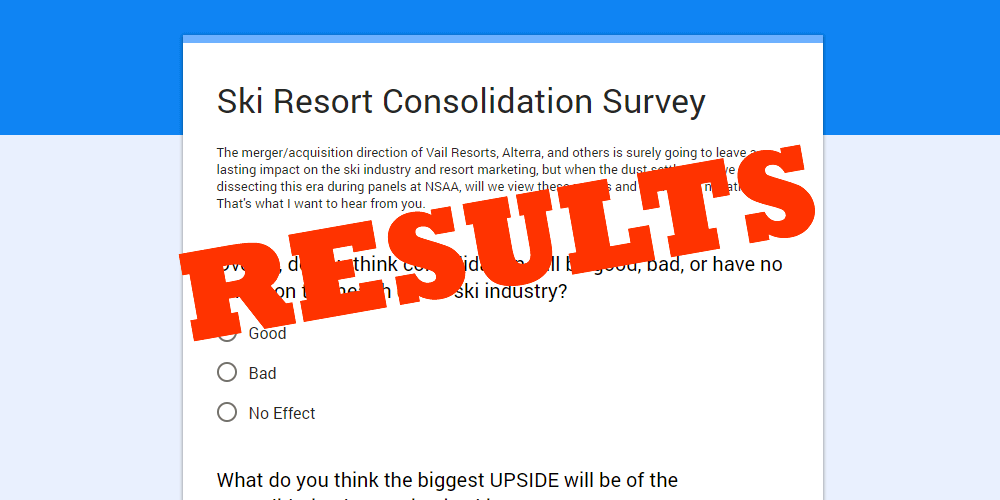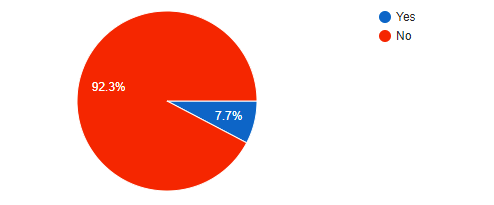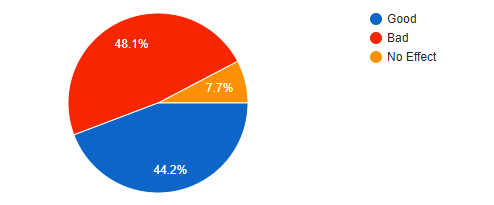Perspectives
What 52 marketers think of ski resort consolidation.


BLANCHARD
I ask for more than just Y/N answers, I ask for some thought. Some insight. So being, I usually shoot for around 50 responses to my surveys. Sometimes that happens in a few hours, sometimes it takes a week for less-interesting topics.
As expected, this one hit that number fairly quickly after a big influx of responses on Friday (actually ended up with 52 because I didn’t catch it in time). Here are the results.
Who dis?
One of the questions I wanted to include was a flag for those that are heavily involved in this trend. So I simply asked those from a Vail or Alterra resort to raise their hands. I only ended up with 4, but I’m okay with that. Traditionally, Vail has kept their thoughts close to the vest and I’d expect Alterra to do the same.
As I mentioned in the survey, I’m not trying to spy on anyone or twist words, but I think it’s useful to see how those who are deeply involved in this trend look at it relative to the rest of us.
Good or Bad
Asked, “Overall, do you think consolidation will be good, bad, or have no effect on the health of the ski industry?” just 4 said “no effect”, 25 said “bad”, and 23 said “good”.
Of the 4 VR/Alterra responses, 3 said “good” and 1 said “no effect”.
The Upsides
Next, I asked “What do you think the biggest UPSIDE will be of the consolidation happening in ski?” Here are all 49 answers (one person didn’t fill the free-response stuff out and two said “nothing”). Note, I’ve added [VR/ALT] before responses from a Vail Resorts or Alterra respondent.
New lifts, snowmaking, restaurants, etc.
Exposure to a broader customer segment
more accessibility to non traditional demographics
Slight uptick in ski travel.
Expose more people to skiing beyond their local ski hill.Crowding at non-Vail/Alterrra resorts will not be an issue as the masses flock to long lift lines for low prices because they can ski at 84 mountains with one pass. ; )
Season pass pricing
The emergence of unique marketing niche’s for non-consolidated resorts to stake a claim to
If it helps a smaller resort survive economic or environment downswings, that could be good. But I am not sure that’s been the case yet with the acquired resorts necessarily.
More money infused into the acquired resorts for continued improvements
Multi-resort passes can lower consumer costs, or perceived costs, especially in the short term.
“Higher perceived value of multi-resort passes may increase number of destination visitors who decide to ski each year, or decide to ski for more than a day or two per season. Actual cost remains high, perceived cost decreases as competition between the conglomerates intensifies.
Better management leads to a more consistently high-quality experience across ski areas. On average, ski trips become more efficient (time-wise), less likely to be derailed by sub-par employees and processes, and more likely to more or less meet expectations that have been set.”
Influx of capital for improvements to ski resort facilities and lifts.
Increased levels of service
Access to capital / debt with market seeing sustainability / viability thanks to VR / Alterra success.
leveraging the economies of scale to help the resorts that are struggling
[VR/ALT] National-level Multi-resort pass initiatives that will ultimately drive frequency and hopefully attract more participants.
More season passes sold.
Affordability (Season Passes)
Freedom of choice for the travelling skier.
Ticket / pass price
Capital for long terms maintenance and resort quality
More investment, more options with a season pass
More targeted marketing by companies that have budgets of enough size to make noticeable noise in the market place.
Pass pricing competition. Increased investment in the skier experience (lifts, facilities, etc)
Providing a economy of scale for marketing dollars to support the conglomerate. More funding avenues available for capital improvements in smaller mountains. Subsidized operations to absorb climate change fluctuations.
On combined marketing effort to promote skiing, which will hopefully benefit the smaller resorts.
Greater flexibility for season pass holders that want to try different mountains.
Midwest and East coast skiers who travel west every year can use their passes at their local ski hill and also at real ski areas.
More capital for infrastructure improvements and investments
Passes are great for our core audience! Plus, the access to capital will be more readily available to improve the overall experience.
With conglomerate ownership usually comes big investment. Smaller resorts suddenly have access to major infrastructure.
[VR/ALT] Ski resorts stay in business, new skiers join the sport
[VR/ALT] More capital available to offer the best guest experience at large destination resorts.
More people will visit more resorts.
lower pass prices (at least initially)
Ability for capital investment in infrastructure.
My hope is more financial stability
Customers: Nice season pass options for destination visitors. Personal/Industry – None
Infrastructure investment, facility updating, assisting areas which may be faltering financially
More pass options for consumers
Destinations will see a skier that they might not have seen before, since they already have a lift ticket
[VR/ALT] Improvement to infrastructure (lifts, snowmaking etc)
Increased awareness on pass sales
Pricing
Increased economies of scale….but it is going to really hurt small areas
Ability of skiers/snowboarders to ski a wider variety of different resorts
More people skiing
Financial efficiency, more net income
The marketing within the ski world will be better
The trends are fairly easy to pick out of that overview:
- More value/options for skiers
- Financial stability and access to capital
- Economies of scale
So that’s the positive.
The Downsides
Here’s what folks said about the other side of the coin. Interestingly, all the “upside” responses totaled 619 words. All the “downside” responses added up to 1,154 words.
“Smaller areas losing revenue
Crowding
standardization of ski areas.. i e most of Vail resorts feel very similar and ski similar
Give it 10 years and under-performing resorts (from a national/global scale) will be eliminated.
Where to start. Generally lack of competition is never a great thing and is generally not great for the consumer in the end. Feels great at first…look at all these resorts I can ski at, but in the end your wallet will feel the pinch. Vail & Alterra will have the money to purchase most any resort they choose and dominate all markets with a flood of resources that the little guys just don’t have access to.
The challenges of the smaller, independent ski areas are going to get larger and more difficult to stay competitive
Lack of competition in pricing and non consolidated resorts having to compete on pricing terms that are not feasible for their financial model
As a passholder, I appreciate how reasonable the cost becomes to ski at one of the resorts in my pass’s portfolio. Where I am getting bummed, though, is seeing how expensive it now becomes to ski a few days at a resort owned by the “other” group. I know I sound old and nostalgic saying this- but it feels like the ability to explore and discover new resorts will be whittled down to “what’s on your big season pass” as everyone migrates to Epic or Ikon. And that’s been happening for the past several years- it’s not a new dynamic w/intro of Ikon this year.
Loss of character, soul, local management, etc.
The arms race will inevitably leave small, independent resorts unable to compete and actually increase the barrier to entry for new skiers.
“Loss of some of the individuality of some ski areas is a big one.More polish and consistency across resorts is a net positive for the *average* ski experience. However, it is probably a net negative for the top 10% of ski experiences. Average comes up, by eliminating poor experiences, but also by removing the random personalities and quirkiness that lead to the best experiences.”
Increasing day ticket price forcing out the occasional middle to upper middle class skier.
Smaller areas not having the resources to grow
Daily lift tix pricing pushing away minorities and quashing growth.
The commodification of the experience and lack of authenticity at the resort level
[VR/ALT] Tougher to survive and an independent resort without a network affiliation.
The focus on season passes will, through increased day pass prices, not promote overall growth of the industry.
Homogenization of the experience. Corporate delivery of a product that will be forgettable resulting in a next generation of skiers who will not be inspired to carry the torch of the frozen flame.
Loss of character at unique resorts.
Day ticket prices and price barriers for getting into the sport.
Loss of brand voice
Corporate feel and loss of old school ski vibe focused on fun
Less family owned vibe
A homogeneous ski industry that caters to the 1%ers. Small resorts doing the work of developing future skiers just to see the ones with the most disposable income going to Vail or Alterra.
Loss of a sense of uniqueness in some mountain communities. Some places actually have it, others think they do but they really don’t.
Loss of individuality and differentiation
Financial
Too much price control.
Eventual monopolies or oligarchies that control the price/experience of all mountains. Think about the telecom world right now. Eventually you’ll have no choice but to ski at a Vail or Alterra mountain…it’s already like that in parts of CO. Plus mountains will lose a lot of the local/community character of ski hills.
Homogenization of the skier experience no matter where you go. I think that base area revitalization will start to look just like all the other Vail or Alterra resorts, sadly.
Loss of FTYR local jobs and a struggle for smaller resorts to stay competitive. Also worried about a mono-culture and cookie cutter resorts.
“Passes are the worst for everyone outside of our core audience as they isolate those that don’t purchase. Basically saying “”sorry, you didn’t purchase one of our pass products, it’s going to cost your $125+ to ski here today!”” This also leads to the ongoing debate on the cost of one-day tickets, which grab the lion’s share of media attention every fall.In addition, the marketing plans for the majority of areas are now so focused on season passes and they have little time, or budget, remaining to market the experience, lifestyle, and what makes each resort unique. Most importantly, why a beginner should put on a bunch of clothes, grab 25 pounds of equipment, and give it a try!”
Those smaller resorts are now a tiny part of a big machine. My concern is that they will lose their character in a bid to make them profitable and, if they aren’t profitable enough, we’ll see closures. Also, there are concerns for staff well-being. Vail have a reputation for ‘downsizing’ existing resort staff.
[VR/ALT] Day ticket prices increase
[VR/ALT] Even higher and more affordable daily lift ticket rates. Not new to the industry but will be more apparent now with the duopoly of Vail and Alterra.
This will likely kill many small resorts – the incubators for beginner skiers and riders.
Loss of character/ passion at the resort level, generic experience driven by corporate branding guidelines and policies. Small business and unique/ strong local communities encourage entrepreneurship.
Lack of culture and identity at many destinations/resorts.Innovation may be harder and if something goes wrong it has much bigger consequences
Customers: Increased pass rates, and pushing smaller resorts out of business. Personal/Industry: Reduced opportunity to move jobs within the ski industry since they (vail especially) seem to higher top jobs from within.
Higher ticket prices and loss of affordable small family-owned and operated resorts. (I’ll champion Crystal Mountain, Michigan here as an example of a solid, well-run single family-pwned resort.)
Lift ticket prices going up and difficulty to find good entry points for beginners and new skiers
No new skiers. The perception that skiing is an expensive sport affecting those potential skiers, especially those nearby to larger resorts where the window pricing is only rising to push people to their pass products
[VR/ALT] Prices go up. Loose the family/person touch
increased prices (non-passes ie lift tickets, lessons, F&B, etc) at Vail / Alterra and the other areas will have to lower pass prices (and raise day ticket prices to cover loss of revenue) to compete. will this ultimately turn away folks that aren’t ready to commit to a season pass?
Loss of character
squeezing the small area, yet demanding them to grow the sport for their future.
The potential to drive more resorts out of business
More people skiing
homogenization of the resorts as efficiencies are implemented
The loss of small ski areas feeding new participants into the sport
Tell me if you read different on either one of these questions, but the trends I saw here were:
- Chance of smaller resorts to struggle and close
- Increased cost of tickets/skiing pricing out skiers
- Loss of character/soul of ski areas
…pleasant surprise.
This may surprise you, but if that’s the collective concern of 50 of you, that’s actually much better than I imagined.
Partly because the perceived cost of skiing is fixable with better education/marketing as an industry and I’ve long though that the perception of “character” or “soul” within certain resorts is mostly an idea that exists only in industry/core skiers. Specifically those looking to confirm a bias against VR.
Don’t get me wrong, I see as many downsides as anyone, but if losing the “soul” or “character” of resorts (something I think only we care about and, to a large extent, exaggerate / falsely-project on resorts based our bias towards their owners) is our worst-case scenario, that’s a good sign to me.
That said, I really appreciated the VR/ALT group’s candor around pricing and how hard it will be to say independent in this climate.
Tomorrow…
So, yeah. Really interesting stuff so farb. But if you remember, I asked one more question in that survey.
It’s the summer of 2023 (five years from now), describe what you think the ski industry will look like. What will be the same? What will be different?
This was a really interesting one to me and I wanted to review it alone, so we’ll tackle that tomorrow.
This post was getting long anyway :)
About Gregg & SlopeFillers
I've had more first-time visitors lately, so adding a quick "about" section. I started SlopeFillers in 2010
with the simple goal of sharing great resort marketing strategies. Today I run marketing for resort ecommerce and CRM provider
Inntopia,
my home mountain is the lovely Nordic Valley,
and my favorite marketing campaign remains the Ski Utah TV show that sold me on skiing as a kid in the 90s.
Get the weekly digest.
New stories, ideas, and jobs delivered to your inbox every Friday morning.


